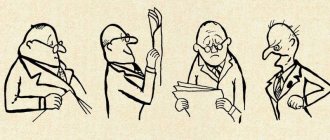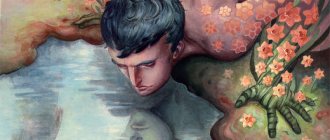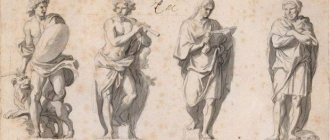Human character has been discussed for several millennia. Even the ancient Greek writer and scientist Theophrastus in his work “Characters” described 31 of their types, each of which was determined on the basis of the dominance of a particular trait. After him, Lev Vygotsky, Carl Jung, Mark Burno and other famous scientists studied this topic. Their developments became the basis of characterology.
Characterology is a branch of psychology whose task is to describe character types, as well as study its essence, structure and development. Who might need knowledge about a person's character?
- For company management – when hiring new employees.
- Managers - in order to competently manage the team and resolve conflicts.
- For profilers - in order to better understand people. So they are necessary for almost any person who wants to interact effectively with others.
Character
It is believed that some traits are leading, while others are secondary. At the same time, they can radically contrast with each other, which forms integral or contradictory characters.
In general, character is manifested in the system of a person’s relationship with the surrounding reality:
- Towards other people: isolation or sociability, self-confidence or self-criticism, humiliation or pride.
- Towards oneself: narcissism or modesty, aggressiveness or friendliness, selfishness or altruism.
- To the point: laziness or hard work, conscientiousness or dishonesty, responsibility or irresponsibility.
- To property: greed or generosity, wastefulness or frugality, sloppiness or neatness.
Character reveals a dependence on the worldview of the individual, his beliefs and moral principles.
The degree of expression of each character can be divided into 3 levels:
- Adequate: the expression of a person’s traits is at the optimal level for his life - and this does not interfere with either him or his environment.
- Accentuated: some character traits are clearly expressed and can interfere with a person’s adaptation to the world around him. This kind of character can be corrected.
- Pathological: pronounced character traits interfere with the people around him and the person himself, harm adaptation in society and lead to frequent violations of social norms. Such a person is called a social psychopath (sociopath).
If we assume that the norm is the behavior of most people, a typical reaction, then everything that is not included in this behavior is not the norm. The lower limit will be pathology, and between them will be accentuation, because it is an intermediate part.
Introduction
In contrast to the concept of “personality,” the concept of “character” covers both socially significant and socially neutral aspects of his behavior. Socially significant behavioral characteristics of an individual are formed by the mechanism of generalization of those modes of behavior that give the best adaptive effect in a given social environment. Human behavior is not determined by innate instincts. But his actions must be carried out with a strong focus and operational certainty. The system of character traits of an individual, as it were, replaces his system of animal instincts, ensuring integrity and consistency, adaptability of behavior. Character is a measure of the balance of the internal and external world, the features of an individual’s adaptation to the reality around him. Character determines the type of interaction of a given individual with the outside world.
In the development of character and its various aspects, a significant role is played by the critical demands of the environment, the decisive circumstances that arise in a person’s life path, especially in childhood and adolescence. However, since character is associated with the worldview of the individual, its intensive, purposeful formation is carried out in adulthood. Z. Freud and E. Fromm made a significant contribution to the disclosure of the essence and typology of character.
Seven radicals of character
This technique was developed by psychologist Viktor Ponomarenko and described in his book “Practical Characterology”. Radicals (accentuations) got their names from terms used in psychiatry.
The essence of this technique is that by external signs (visual psychodiagnostics) one can determine the components of character - radicals. That is, in real time you can draw a certain conclusion about a person’s character based on his manner of communication and appearance.
Seven radicals:
- hysterical (demonstrative);
- paranoid (purposeful);
- schizoid (strange);
- epileptoid (two types: excitable and stuck);
- emotive (sensitive);
- hyperthymic (cheerful);
- anxious (fearful).
Let's consider each radical separately.
Hysterical (demonstrative)
Usually these people:
- want to be liked by others;
- behave demonstratively and want to be noticed;
- prone to mannerisms;
- They talk a lot, attracting attention to themselves.
Facial expressions: emotions look exaggerated - if there is sorrow on the face, then it must be universal, sadness with tears, too wide smiles.
Clothes: defiant, bright, extravagant.
Speech: expressive and emotional with dramatic pauses.
Gestures: accentuated poses and picture gestures.
Paranoid (goal-oriented)
Usually these people:
- confident, self-confident;
- listen only to their own opinion;
- strategists, but not tacticians;
- their scale is enormous and their goals are global.
They go over their heads, guided by the principle “Whoever is not with us is against us.”
Facial expressions: confident, authoritative.
Clothes: neatness, nothing superfluous.
Speech: Mentoring, confident tone.
Gestures: pointing, chopping, broad.
Schizoid (strange)
These are pronounced introverts, they are characterized by unpredictable behavior and creativity without patterns. They decide for themselves which laws to obey; they are “not like everyone else.” They often have an awkward appearance.
Facial expressions: mismatch between gestures and facial expressions (clenched fists and joy on the face).
Clothing: inharmonious and sloppy, there is no clear image.
Speech: highly intelligent, sometimes abstruse.
Gestures: awkward, inconsistent, angular.
Epileptoid (excitable)
These are tough, even cruel people. They are always ready to engage in battle and conflict. They tend to blindly believe instructions, saying: “I was just following orders.”
Facial expressions: aggressive, direct gaze, constrained and small facial expressions.
Clothing: sporty or formal style.
Speech: harsh, slow, sluggish.
Gestures: heavy.
Epileptoid (stuck)
Such people have a hard time switching from one to another. They are punctual, systematic, pragmatic, unhurried. They live by the principle: “My home is my castle,” which also applies to other aspects of their life. If they call you a friend, they will never betray you.
Facial expressions: confident, direct, sometimes even heavy gaze.
Clothes: neat.
Speech: slow, sluggish.
Gestures: verified, clear.
Emotive (sensitive)
Such people have pronounced kindness and empathy, so they can empathize with others. They love watching movies with emotional scenes. They tend to avoid conflicts by yielding to their interlocutor. They know how to listen and often do not know how to argue.
Facial expressions: uncertain, weak.
Clothes: nice, soft, comfortable.
Speech: quiet.
Gestures: smooth.
Hyperthymic (cheerful)
These people love life in all its manifestations, they are optimistic and see the good in almost all situations. They have a great sense of humor. They are flexible when solving problems and know how to quickly switch from one task to another.
Facial expressions: cheerful, lively, energetic.
Clothes: comfortable, versatile, not restricting movement.
Speech: enthusiastic. They can talk about anything, the main thing is the process and sudden flashes of inspiration.
Gestures: fast, cheerful.
Anxious (fearful)
Such people are characterized by increased anxiety, they are constantly insuring themselves against mistakes, checking everything several times. They are afraid to make decisions themselves and close themselves off when communicating. They have their own calming rituals (for example, spitting over the shoulder).
Facial expressions: uncertain, weak.
Clothes: closed, dim.
Speech: uncertain, quiet.
Gestures: constrained, self-soothing.
You should understand that the above examples according to Ponomarenko are very conditional, because many people demonstrate different radicals, depending on the situation. However, some conclusions can be drawn. Learn to observe and analyze - and then with experience you will begin to correctly interpret the behavior of others, drawing conclusions about people on this basis.
We wish you good luck!
Did you like the article? Join our communities on social networks or our Telegram channel and don’t miss the release of new useful materials: TelegramVKontakteFacebook
We also recommend reading:
- Storytelling
- The “7 radicals” technique by Viktor Ponomarenko. Is it possible to determine a person's character by appearance?
- Burno's typology
- Character
- Psychological picture
- Personality types by socio-psychological qualities
- Personality typologies in psychology
- Black Triad
- Self-knowledge: how to understand and use your character traits
- “What is in your character?”
- Conditions for character formation
Key words:1Self-knowledge, 4Profiling, 4Self-knowledge
Character types, their expression, “weak points”
Currently, there are many classifications of character. Particularly interesting and meaningful are those that arose in the border area at the intersection of psychology and psychiatry. They contain the experience of talented clinical scientists who worked directly with people, observed their behavior, studied biographies, talked with their relatives, and helped in difficult life situations and problems. Here you can find such names as K. Jung, E. Kretschmer, P. B. Gannushkin, K. Leongard, A. E. Lichko, M. E. Burno, M. Z. Dukarevich and others. The first classifications contained only two types (K. Jung, E. Kretschmer), nowadays there are many more of them.
We will focus on eight main types, which, with some variations, are found among most authors. Specific examples and illustrations will be taken from the observations of the same authors, fiction, our own personal experience and the stories of other people.
People differ in the degree to which their character traits are expressed. In one they are very noticeable, in the other they seem to be smoothed out, softened. The best way to get to know characters is through examples of their expressed degrees (accentuations), which is what we will do in this book. By the way, such pronounced characters are observed in more than half of the population. This means that in every family there is likely to be a person with an accented character. If we talk about teenagers, then “sharp corners” of character are found in most of them, although they usually smooth out over the years.
In general there are no bad and good characters. Each character has its own strengths and weaknesses. Strong properties are usually visible, they speak for themselves, but weak ones often still need to be recognized.
Talking about character weaknesses brings us to the very important concept of character weaknesses. Such a “place” means a person’s increased sensitivity, or vulnerability, to certain conditions. Such conditions are different for different characters. One person finds it difficult to bear the loss of attention from loved ones, another finds it difficult to bear the restriction of his freedom, and a third cannot bear the burden of responsibility and high expectations. When there is a load on a weak point of character, a person gives a negative reaction. This can be expressed in different ways, from withdrawing into deep resentment to “breaking dishes” and hysterics. If stress on a weak point is repeated frequently and for a long time, then the experience of trouble intensifies, sometimes leading a person to a state of “impossibility”: a child runs away from home, a spouse gets divorced, an employee submits a letter of resignation.
Hence it is clear that knowledge of the “weak points” of each character is of invaluable practical importance. It helps to behave competently with a person, preventing unnecessary complications in the family and at work, and mistakes in raising a child. We will definitely dwell on the weak points of each character when getting to know individual types.
The role of conflict situations in character formation
The most profound, lasting changes in character occur after emotional experiences due to conflicts occurring in childhood. A striking example of this is the transition of a child from one school to another. Changing the communication group, finding a compromise between home, where they say “must”, and school, where they come up with new demands. In such situations, character is not only discovered, but also formed.
Research shows that among surveyed people from 25 to 60 years old, more than 70% noticed changes in their character in adolescence, with the main factor being the decisive action in critical circumstances, and often in conflict situations.
Exactly what way out of this or that conflict a person found depended on what action he decided on: either one that alienated him from people, or one that brought him closer to the team. We should not forget that the action in such situations depends on the inherent development and upbringing, although, having an excellent upbringing and a favorable environment behind him, the same person can decide on different actions. It follows from this that everyone forms their own character based on the decision of this or that action. Consequently, the formation of character is impossible without self-education.











